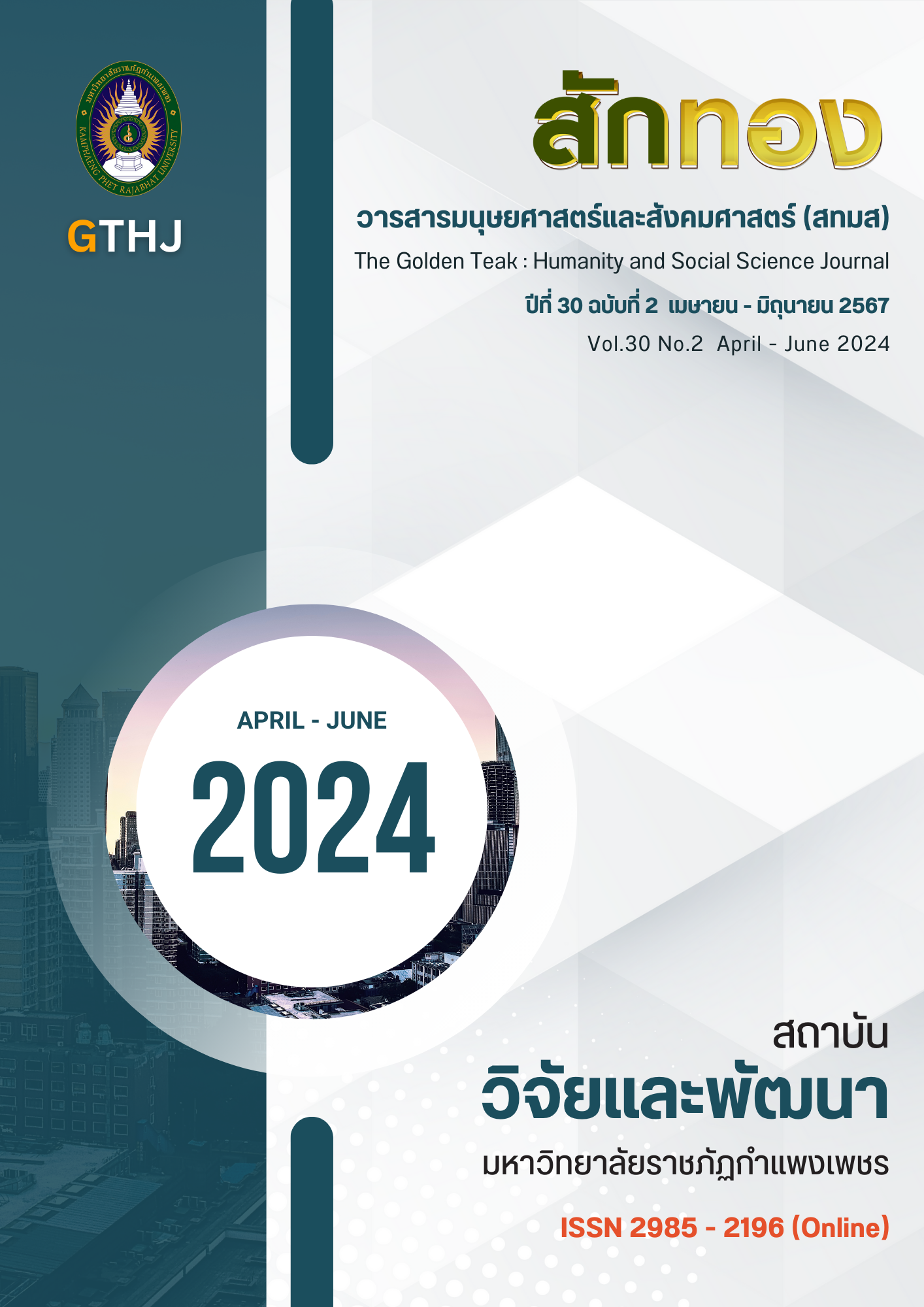Application of Geo-informatics to Analyze Forest Fire Hazardous, Vulnerability, and Risk Areas in Mae Sot District, Tak Province
Main Article Content
Abstract
The purpose of this research was to apply of Geo-informatics to analyze forest fire hazardous, vulnerability, and risk areas in Mae Sot District, Tak Province. There are research methodologies consisting of surveying and collecting data from geographic information systems (GIS) and remote sensing used in the analysis, selection of criteria and rule determination of analysis, analysis of hazardous and Vulnerability areas with a multi-criteria
decision analysis process, analysis of risk areas, and knowledge extraction from the results. Forest fire hazard area analysis 14 analytical criteria were used, namely, forest type, distance from the burned forest area from the normalized burn ratio (NBR) analysis, density of MODIS hotspots, slope, elevation, aspect, average of temperature, distance from village, road, agricultural land, shifting plantation, stream, water resource, and tourist attractions. The analysis of forest fire vulnerability uses 4 criteria; the number of villages nears the forest boundary, forestry ratio, population and household density, and relative wealth index (RWI). The risk area analysis was evaluated using a hazard-vulnerability classification matrix. The study found that there were 1.49% of the very high areas, 16.19% of the high risk areas, 31.86% of the moderate risk areas, 4.85% of the low risk areas, and 45.61% of the non-risk areas. Herein, Dan Mae Lamao and Phawo sub-districts have a higher overall risk than other areas.
Article Details

This work is licensed under a Creative Commons Attribution-NonCommercial-NoDerivatives 4.0 International License.
บทความที่ได้รับการตีพิมพ์เป็นลิขสิทธิ์ของวารสาร สักทอง : วารสารมนุษยศาสตร์และสังคมศาสตร์ สถาบันวิจัยและพัฒนา มหาวิทยาลับราชภัฏกำแพงเพชร
ข้อคิดเห็นใดๆ ที่ปรากฎในวารสารเป็นวรรณกรรมของผู้เขียนโดยเฉพาะ ซึ่งมหาวิทยาลัยราชภัฏกำแพงเพชรและบรรณาธิการไม่จำเป็นต้องเห็นด้วย
References
Cetin, M., Pekkan, Ö., Özenen, M., Ilker, A., Suhrabuddin, N., Masoud, D. & Saye, C. (2022). GIS-based forest fire risk determination for Milas district, Turkey. Natural Hazards, 113(1),
-17.
Chengcheng Gai, Wenguo Weng & Hongyong Yuan. (2011). GIS-based Forest Fire Risk Assessment and Mapping. Fourth International Joint Conference on Computational Sciences and Optimization, 1,240-1,244. Kunming and Lijiang City, China.
Chuvieco, E. & Congalton, R. G. (1989). Application of Remote Sensing and Geographic Information Systems to forest fire hazard mapping. Remote Sensing of Environment, 29(2), 147-159.
Cocke, A.E., Fule, P.Z. & Crouse, J.E. (2005). Comparison of burn severity assessments using differenced normalized burn ratio and ground data. International Journal of Wildland Fire, 14(2), 189-98.
Eastman, J.R. (1999). Multi-criteria evaluation and GIS. In Goodchild, M. F., Maguire, D.J., & Rhind, D.W. (Eds.). Geographical Information Systems, 493-502, USA: Longley, John Wiley and Sons.
Guanghua Chi, Han Fang, Sourav Chatterjee & Joshua, E.B. (2022). Microestimates of wealth for all low-and middle-income countries. PNAS, 29(3). 1-11.
Keeley, J.E. (2009). Fire intensity, fire severity and burn severity: A brief review and suggested usage. International Journal of Wildland Fire, 18(1), 116-126.
Key, C. & Benson, N. (2005). Landscape assessment: Ground measure of severity; The Composite Burn Index, and remote sensing of severity, the Normalized Burn Index. In Lutes, D., Keane, R., Caratti, J., Key, C., Benson, N., Sutherland, S. & Gangi, L., (Eds.), FIREMON : Fire Effects Monitoring and Inventory System. USA: Rocky Mountains
Research Station, USDA Forest Service: Fort Collins.
Malczewski, J. (1999). GIS and Multicriteria Decision Analysis. Canada: John Wiley and Sons.
NASA. (2022). Fire Information for Resource Management System. [Online]. Available : https://firms.modaps.eosdis.nasa.gov/ [2022, April 28].
Petrakis, M., Psiloglou, B. & Lianou, M. (2005). Evaluation of forest fire risk and fire extinction difficulty at the mountainous park of Vikos-Aoos, Northern Greece: use of Remote Sensing and GIS techniques. International Journal of Risk Assessment and Management, 5(1), 50-65.
Rajeep, K.J., Saumitra, M., Kumaran, D.R. & Rajesh, S. (2002). Forest fire risk zone mapping from satellite imagery and GIS. International Journal of Applied Earth Observation and Geoinformation, 4(1), 1-10.
Rinner, C. & Malczewski, J. (2002). Web-enabled spatial decision analysis using ordered weighted averaging (OWA). Journal of Geographical Systems, 4(4), 385-403.
Roszkowska, E. (2013). Rank Ordering Criteria Weighting Methods-A Comparative Overview. J. Dedicated Needs Sci. Practice, 5(65), 14-33.
Roy, D.P., Boschetti, L. & Trigg, S.N. (2006). Remote sensing of fire severity: Assessing the performance of the normalized burn ratio. IEEE Geoscience and Remote Sensing Letters, 3(1), 112-116.
Ruthamnong, S. (2022). Geoinformatics for Natural Disaster Management. Kamphaeng Phet: Kamphaeng Phet Rajabhat University. [In Thai]
Ruthamnong, S., Wattanatadsanee, B. & Klomklumnum, I. (2023). Geo-informatics innovation to create spatial knowledge for mitigation the natural and human activity threats of quality of life, Mae Sot District, Tak Province. National Research Council of Thailand (NRCT). [In Thai]
Stillwell, W.G., Seaver, D.A. & Edwards, W. (1981). A Comparison of Weight Approximation Techniques in Multiattribute Utility Decision-Making. Organizational Behavior and Human Performance, 28(1), 62-77.
Tak Provincial Office, Tak City Hall. (2021). Information for the administration of Tak Province. Tak : Tak Provincial Office, Tak City Hall. [In Thai]
USGS. (2022). Landsat Download Earth Explorer. [Online]. Available : https://earthexplorer.usgs.gov/ [2022, April 28].
van Wagtendonk, J.W., Root, R.R. & Key, C.H. (2004). Comparison of AVIRIS and Landsat ETM+ detection capabilities for burn severity. Remote Sensing of Environment, 92(3), 397-408.
XU Dong, DAI Li-min, SHAO Guo-fan, TANG Lei & WANG Hui. (2005). Forest fire risk zone mapping from satellite images and GIS for Baihe Forestry Bureau, Jilin, China. Journal of Forestry Research, 16(3), 169-174.
YIN Hai-wei, KONG Fan-hua & LI Xui-zhen. (2004). RS and GIS-based forest fire risk zone mapping In Da Hinggan Moutains. Chinese Geographical Science, 14(3), 251-257.


